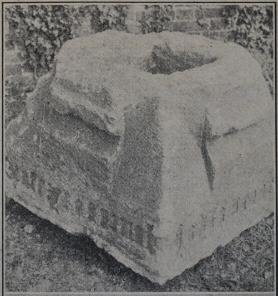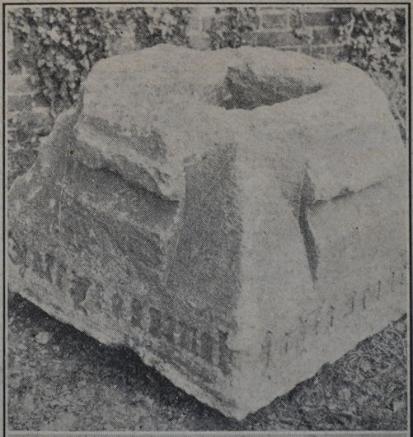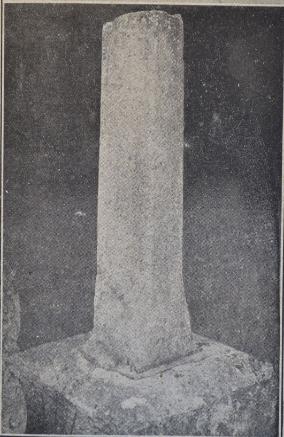The base of the old village cross, Cambridge Chronicle , 31 August 1921, p. 7.
Old Wayside Cross: Interesting Trumpington Discovery
Cambridge Chronicle , 31 August 1921, p. 7.
The base of an old cross was unearthed at Trumpington while the foundations were being dug for the village war memorial. A portion of the shaft of the cross has been kept in the churchyard for very many years, although no one knew the history of it. A fragment of the bottom of the shaft was found with the base. Writing in reference to the interesting discovery, the Vicar of Trumpington (the Rev. A. C. Moule) says:- When foundations were being dug for our rather belated war memorial last Wednesday morning, a large stone was struck only a few inches below the surface of the road. The workmen were filling in the earth they had removed, and would soon have begun to lay concrete over this stone, when the schoolmaster, Mr. P. R. Robinson, happened to pass by, and saw at once that the stone was of considerable age and interest. Thanks to his prompt report of what he had seen and to the interest of Dr. W. W. Wingate, the stone was carefully lifted from its place, and proved to be the base of an old cross, a block of Barnac stone about 2ft. 4in. square at the base and worked to an octagon at the top. In the top is the socket, about 1ft. square, into which the shaft of the cross fitted. A large part of the shaft has long been kept in the churchyard, though no one knew the history of it with any certainty, and a fragment of the bottom of it was found with the base. The base stood, I hear, quite upright on a bed of ordinary earth.
On 31 August 1921, the Cambridge Chronicle included an account of the discovery of the base of the old village cross at Cross Hill, with information contributed by Rev. A.C. Moule.
Round the four sides near the bottom runs a deeply cut inscription which on three sides is easily legible: “.Orate Pro animabus/Johannis stokton/et agnetis uxoris ei/us . . ./.” The fourth or north side (as the stone stood when it was found) will probably be read without difficulty by experts. The north-east corner was evidently chipped off some years ago when the gas main was laid, but no whisper of the existence of the stone seems to have got abroad at that time. The spot on which it was found is known within a few inches, though no actual measurements were made; and it did not occur to the War Memorial Committee to delay the putting down of their new concrete base for half a day so that the ground might be searched for other fragments. The place is known as Cross Hill or The Cross. Otherwise there seems to be no memory of tradition of the thing having been seen nor is it mentioned in any description of Trumpington known to me. That it was in position, shaft and all, at the end of the 17th century is, however, made likely by this entry in the Churchwardens’ Minute Book under the date of April, 1691: “And lastly wee doe order an Exact Coppy of these presents to be forth with written out; and affixed on the publick Crosse of this Town of Trumpington.”
Since the above was written we hear that Dr H. Guillemard, who has examined the stone, is of the opinion that there was no lettering on the fourth side, but that the marks there were probably made to hold a brass plate.
Transcribed by Wendy Roberts, December 2018.
For further information, see the Cross Hill page.

“The base of the old cross recently unearthed” and “The portion of the shaft that has long been kept in the churchyard” , Cambridge Chronicle , 31 August 1921, p. 7.

